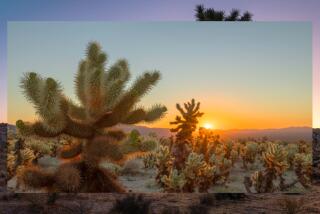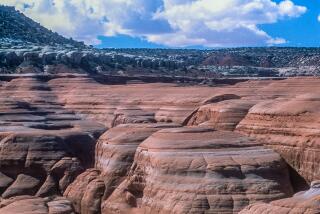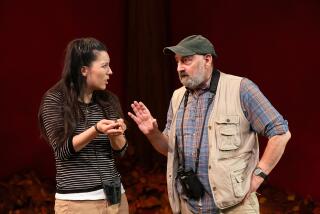Raptors, Magnificent Rulers of Boise’s Sky
- Share via
BOISE, Ida. — It’s a memory I try to suppress, snuggled deep in the back of my mind. But it is a memory that persists, dragging itself to the front any time I see a wonderful, wild creature on the wing.
It is a memory of violence, of shame, a senseless moment of killing.
I was young, perhaps 17, hunting for grouse on a Pennsylvania hillside covered with dense spruce trees and wild grape vines. I cradled my beloved Ithaca featherweight repeater, a beautiful 20-gauge shotgun, in my arms as I walked along hoping to flush a ruffed grouse from the undergrowth.
A Gray Shadow Fell
Suddenly a gray shadow swirled from the trees, crossing in front of me. I fired, thinking my second grouse of the day was in the bag. The shadow cartwheeled out of the sky, striking the low branches of a spruce and tumbling to the leaf-carpeted floor.
I walked over to the bird and discovered that it wasn’t a grouse at all that I had shot but a screech owl, a gray-feathered ball of fluff that--although mortally injured--stared defiantly at me with its yellow eyes.
I picked up the little owl, horrified at my mistake, tucked it under my arm and ran to the car. I rushed the little creature to the nearest veterinarian. Although he tried his best, the handsome owl soon closed its eyes and it died as I held it in my hands.
That night, as I went to bed, I dreamed of that beautiful owl, which was doing no other creature (except for the occasional mouse) any harm. I remembered its fragile beauty, its great courage and its last, short breath. And I quit hunting. I haven’t picked up a shotgun since that day, nor will I.
But I have continued to walk in woods from Colorado to California and observe the wild birds. And each time I do, I think of that little creature I so carelessly killed.
That little owl was never closer or clearer in my thoughts than during a tour of the extraordinary lands around Boise, great deserts and mountains where raptors (hawks, eagles, falcons, owls) ride the wind like tiny feathered gliders.
Boise Beauty, Splendor
Boise County has the largest concentration of raptors in the world and visitors to this very pleasant small city can enjoy their beauty and splendor at two places.
On the outskirts of Boise is the World Center for Birds of Prey, home of the Rocky Mountain Peregrine Falcon Program, which has helped raise hundreds of the endangered birds for release throughout the United States.
About 12,000 tourists visit the facility yearly, coming to see the sleek birds and learn how they have been saved from extinction, a fate that seemed certain in 1960 when fewer than 100 existed, down from a high of 4,000. There was not one bird alive east of the Mississippi River and only a very few in the remote canyons of the West.
But the population of the 200-m.p.h. dive bombers is now nearly 1,200, thanks in great part to the release, over the years, of 2,000 birds by the Peregrine Program.
Visitors to the World Center are given a short orientation talk, which includes the appearance of one or two of the birds. They also see a video about peregrines and are allowed to observe eggs being incubated. If your timing is right, you may even see a few of the snowy white puffs that are week-old chicks.
Later, visitors walk to the Morlan Nelson Tropical Birds Building and see peregrine and tawny eagles in their breeding rooms, sitting majestically on perches and devouring quail. (The center raises nearly 200,000 quail a year to feed the raptors.)
Snake River Sanctuary
Once they have toured the center, visitors should drive to the Snake River Birds of Prey Area, a 482,000-acre sanctuary that has the largest concentration of raptors anywhere. On the one-hour drive to the center you’ll pass acres of sagebrush, see dozens of ground squirrels standing by the dirt road and watch short-eared owls cruising for lunch.
By the handsome turn-of-the-century Swan Falls Dam you will climb into a boat manned by a naturalist and move upriver, eyes on the towering cliffs for a glimpse of a golden eagle or a prairie falcon, a Swainson’s hawk or a great horned owl.
On one recent trip a group of tourists saw the cliffside nest of a pair of prairie falcons, the two chicks yelping for food; witnessed a falcon protecting its nest by attacking a coyote, and saw the giant stick nests of golden eagles, with the parents of a single chick riding the winds high above while waiting for onlookers to leave.
The group also beached their boat, walked up a side canyon to see ancient Indian settlements and took an interpretive trail that winds from the upper road to the very lip of the canyon.
But mostly they enjoyed the heat of the canyon and the commentary of Morlan Nelson, who has spent most of the last 40 years trying to save the eagles, hawks and falcons of the world. That the Bureau of Land Management set aside the Birds of Prey area is in large degree due to his efforts.
‘A Big Mac with Legs’
His expertise made the trip particularly rewarding. He pointed out individual birds, riding the updrafts of the canyon looking for what Nelson calls “a Big Mac with legs,” a ground squirrel. A bonus to the bird watching was the physical magnificence of the Snake River Canyon, a brown, slate and dust-colored canyon whose walls rise 700 feet above your head.
In the midst of this wild and windy land, with only the rumble of boat engines to sully the otherwise noiseless canyon, it was a privilege to see the raptors--the hawks and the owls, the kestrels and the falcons, the harriers and the eagles--as they sailed high above us, graceful in a blue sky.
It was good to watch the birds and not harm them, to send them on their way with luck and pleasant thoughts. It was good to see these birds as they should be seen, not crumpled and dying in one’s arms.
-- -- --
Whitewater Shop River Tours provide day trips through the canyon from now until early November and from mid-April to mid-June. The trips cost $74.52 per person for the day, which includes transportation to and from Boise, a full lunch, nature commentary and the float up and down the canyon. Information: 8799 W. State St., Boise, Ida. 83703; (208) 342-0750.
The World Center for Birds of Prey is open weekdays; tours can be arranged by calling for an appointment. Information: World Center for Birds of Prey, 5666 W. Flying Hawk Lane, Boise, Ida. 83709; (208) 362-3716.
Boise is a delightful small city, with greenbelts and parks cutting along the Boise River--a perfect place for strolling and biking. Among its tourist attractions is the Old Idaho Penitentiary. It’s a museum where you can see a film of prison life that was once so mean that it made Alcatraz look like a country club. The prison also contains a transportation museum.
Also worth visiting is Julia Davis Park, which contains the city zoo, a 1920 series Union Pacific railroad engine and a lovely rose garden. The capitol is worth a look, and take the Boise Tour Train ($3.75) for a glimpse of some of the city’s fine old neighborhoods.
Outside town--in addition to the Snake River Birds of Prey Area--are other attractions including Bruneau Dunes State Park; Idaho City, an 1860s gold-mining town, and the Ste. Chapelle, Weston and Facelli wineries, all of which provide tastings.
Among the best hotels in town are the Compri and the Red Lion Inn, both about $65 to $70 for a double room.
Boise information: Convention and Visitors Bureau, P.O. Box 2106, Boise, Ida. 83701; (208) 344-7777 or (800) 635-5240.
More to Read
Sign up for The Wild
We’ll help you find the best places to hike, bike and run, as well as the perfect silent spots for meditation and yoga.
You may occasionally receive promotional content from the Los Angeles Times.






